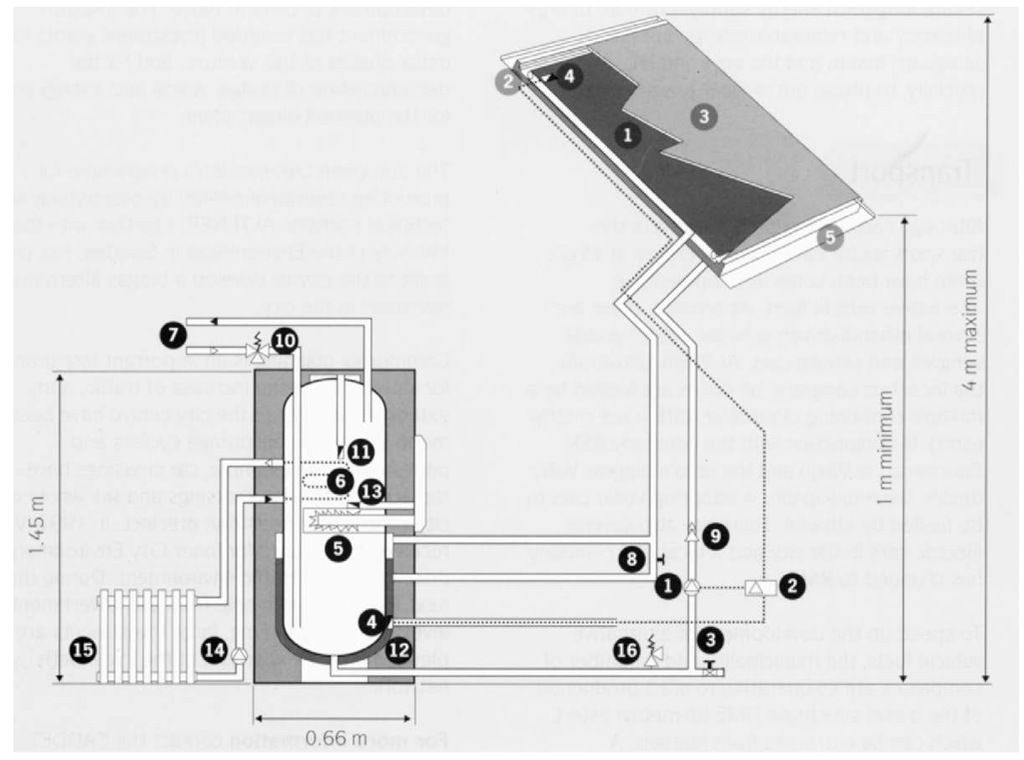Solar thermal hybrids
In most instances in the UK climate it would be necessary to have backup heat for the hot water system. Usually this is provided by an electric immersion heater. However, lower running costs can be realized with a solar-gas combination cylinder. The principle here is that a 240 litre tank is heated by flat plate solar collectors supplemented by a gas burner within the body of the cylinder. It provides space heating and domestic hot water. A heat exchanger coil in the upper half of the tank heats the central heating circuit. A production solar-gas combination boiler with 2.83 m2 of solar collector produces 4 GJ/year; a 5.4 m2 collector supplies 5.64 GJ/year. A test involving 25 units showed a boiler efficiency of 90.1 per cent. On average, consumers saved 650 m3 of natural gas compared with their former systems. Based on the current price of gas (1999), the payback time is 13 years. However, gas prices are rising. The other factor to consider is that the system would be almost zero carbon if at some future date it employed biogas (Figure 8.11)
Flat bed solar collector
(1) Absorber
(2) 40 mm insulation plate, CFC-free
(3) Low-iron tempered glass
(4) Temperature sensor in the collector
(5) Aluminium rim
Cylinder
(1) Pump
(2) Delta temperature control
(3) Supply tap
(4) Temperature sensor in the boiler
(5) Gas burner
(6) Central heating coil
(7) Hot and cold water pipes
(8) Level tap
(9) Maximum flow restrictor
(10) Intake combination
(11) Thermostat control for boiler
(12) Boiler insulation material, CFC-free
(13) Outside temperature control
(14) Central heating pump
(15) Radiator
(16) Maximum pressure valve
Figure 8.11 Solar-gas combination cylinder.
Economics
Unfortunately, while this technology is one of the cheapest renewable options it is still not cost-effective weighed against fossil-based energy, with a pay-back time of around 20 years. However, this cost-effectiveness can be considerably improved if complete roof renovation is being undertaken and the flat bed collectors integrated into the new roof. The reality is that the market will only grow significantly at this stage if:
• There is direct or indirect government support for the technology;
• Following this intervention, the market expands to achieve economies of scale;
• The product is of the highest quality and fitting procedures simplified and standardized;
• There is an adequate network of trained and accredited specialist installers.
Main points
• Hot water cylinders should have at least 100 mm of insulation.
• One- or two-person households may find it more economical to use point heaters for DHW.
• Gas is more cost-effective than electricity for DHW heating.
• Solar thermal collectors can significantly boost DHW, though they are still some way from being cost-effective.
• In the UK, solar collectors should be tilted in a southerly direction with virtually no overshading. Certain types are particularly appropriate for the cloudy conditions so common in this climate.

